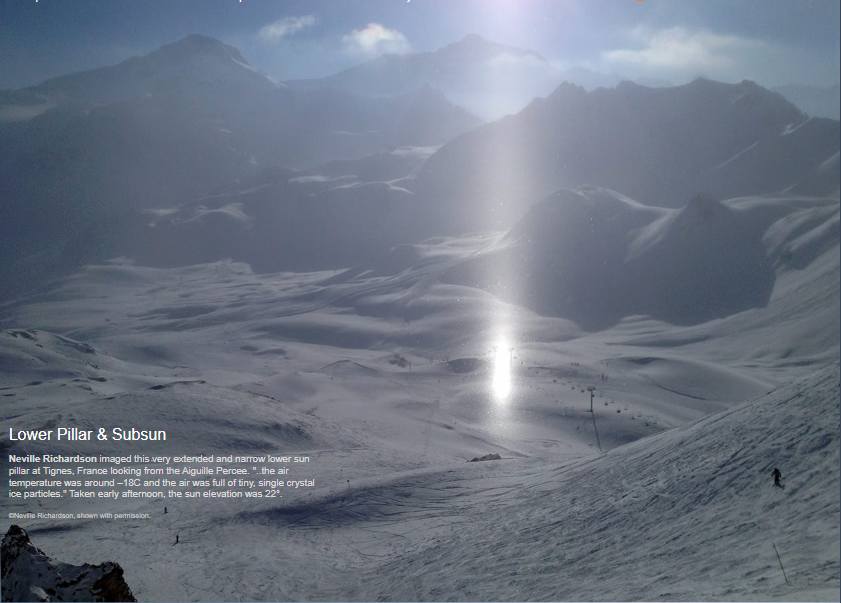OPOD - Lower Pillar & Subsun
OPOD - Lower Pillar & Subsun: A Fascinating Optical Phenomenon
Atmospheric optics never ceases to amaze us with its stunning displays of light and color. One such phenomenon is the lower sun pillar and subsun, which create a mesmerizing spectacle in the sky. Captured by Neville Richardson in Tignes, France, these images showcase the beauty of this optical wonder. Let's delve deeper into the intricacies of the lower sun pillar and subsun.
Both the lower sun pillar and subsun are formed through the same process. Sunlight reflects off large hexagonal faces of plate-shaped ice crystals or horizontal columns. These crystals, known as "diamond dust," float in subzero air, creating the perfect conditions for the formation of these optical phenomena.
The reflection from the ice crystals can occur either from the exposed upper face or internally from the lower face. This variation in reflection angles contributes to the diverse appearances of the lower sun pillar and subsun. The extent to which the ice crystals wobble around their equilibrium horizontal orientation determines the visual outcome.
Here are some key points to understand about the lower sun pillar and subsun:
-
Lower Sun Pillar: When the ice crystals experience significant wobbling, they produce tall pillars of light extending below the sun. These pillars can be elongated and narrow, as seen in Neville Richardson's image from Tignes, France.
-
Subsun: In contrast, when the ice crystals wobble only slightly, they create a subsun. The subsun appears as a disk-like reflection of the sun, positioned at the same distance below the horizon as the actual sun is above it. This creates a mesmerizing mirror effect in the sky.
-
Wobbles and Orientations: The size and orientation of the ice crystals play a crucial role in determining the magnitude of wobbling. Large wobbles result in taller pillars, while smaller wobbles give rise to the subsun. The equilibrium horizontal orientation of the ice crystals contributes to the stability of these optical phenomena.
-
Weather Conditions: The formation of lower sun pillars and subsuns requires specific atmospheric conditions. In this case, the air temperature was approximately -18°C, and the air was filled with tiny, single-crystal ice particles. These icy particles served as the canvas upon which the sun's rays created their artistic display.
-
Time of Day: The time of day also influences the appearance of lower sun pillars and subsuns. Neville Richardson captured these images in the early afternoon when the sun's elevation was at 22°. This angle of the sun's rays interacting with the ice crystals contributes to the unique characteristics of the optical phenomena.
In conclusion, the lower sun pillar and subsun are captivating atmospheric optics phenomena that result from the reflection of sunlight off plate-shaped ice crystals. The wobbling and orientation of these crystals determine whether a tall pillar or a disk-like subsun will be observed. The specific weather conditions and time of day contribute to the formation and appearance of these mesmerizing displays in the sky. Keep an eye out for these optical wonders, as they offer a glimpse into the breathtaking beauty of our atmosphere.

Lower Pillar & Subsun
Neville Richardson imaged this very extended and narrow lower sun pillar at Tignes, France looking from the Aiguille Percee. "..the air temperature was around –18C and the air was full of tiny, single crystal ice particles." Taken early afternoon, the sun elevation was 22°.
©Neville Richardson, shown with permission.

Both the lower sun pillar and the subsun (the bright patch at the base of the pillar) are produced in the same way. Sun rays reflect from large hexagonal faces of plate shaped ice crystals. Pillars can also be made by horizontal columns. In this case the crystals were floating in the subzero air as 'diamond dust'.
The reflection from plates can be from the exposed upper face or internally from the lower one.
The extent that the crystals wobble around their equilibrium horizontal orientation determines what is seen. Large wobbles produce tall pillars, very small wobbles give a subsun - very nearly a disk like reflection of the sun the same distance below the horizon as the sun is above it.
Note: this article has been automatically converted from the old site and may not appear as intended. You can find the original article here.
Reference Atmospheric Optics
If you use any of the definitions, information, or data presented on Atmospheric Optics, please copy the link or reference below to properly credit us as the reference source. Thank you!
-
<a href="https://atoptics.co.uk/blog/opod-lower-pillar-subsun/">OPOD - Lower Pillar & Subsun</a>
-
"OPOD - Lower Pillar & Subsun". Atmospheric Optics. Accessed on April 23, 2024. https://atoptics.co.uk/blog/opod-lower-pillar-subsun/.
-
"OPOD - Lower Pillar & Subsun". Atmospheric Optics, https://atoptics.co.uk/blog/opod-lower-pillar-subsun/. Accessed 23 April, 2024
-
OPOD - Lower Pillar & Subsun. Atmospheric Optics. Retrieved from https://atoptics.co.uk/blog/opod-lower-pillar-subsun/.